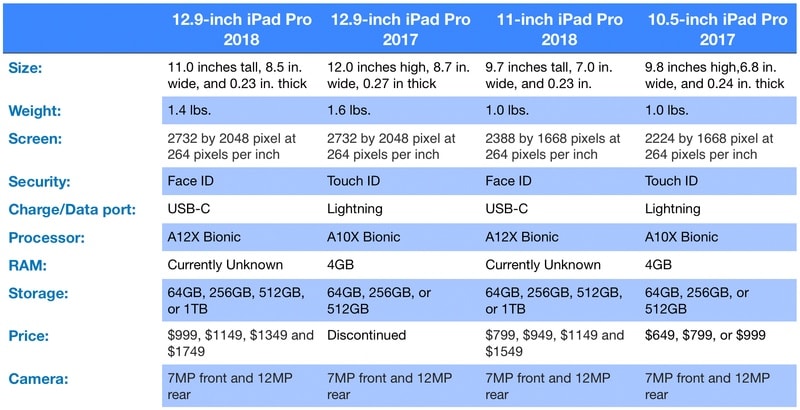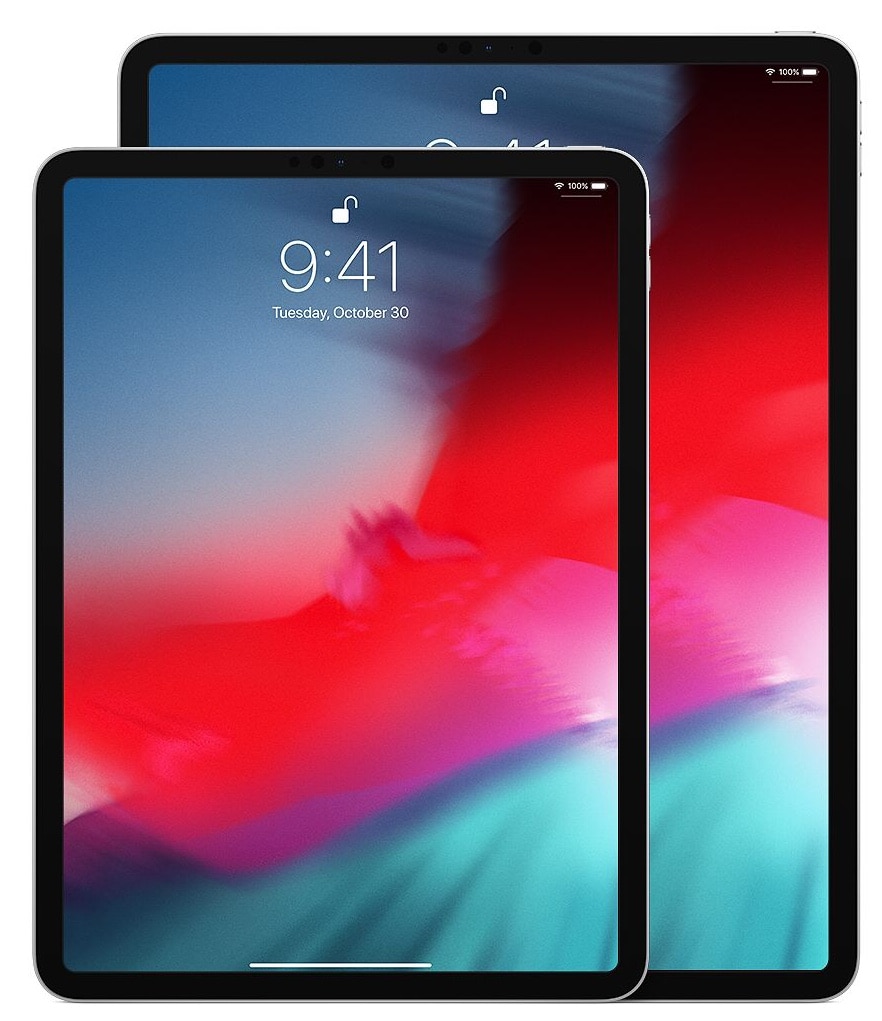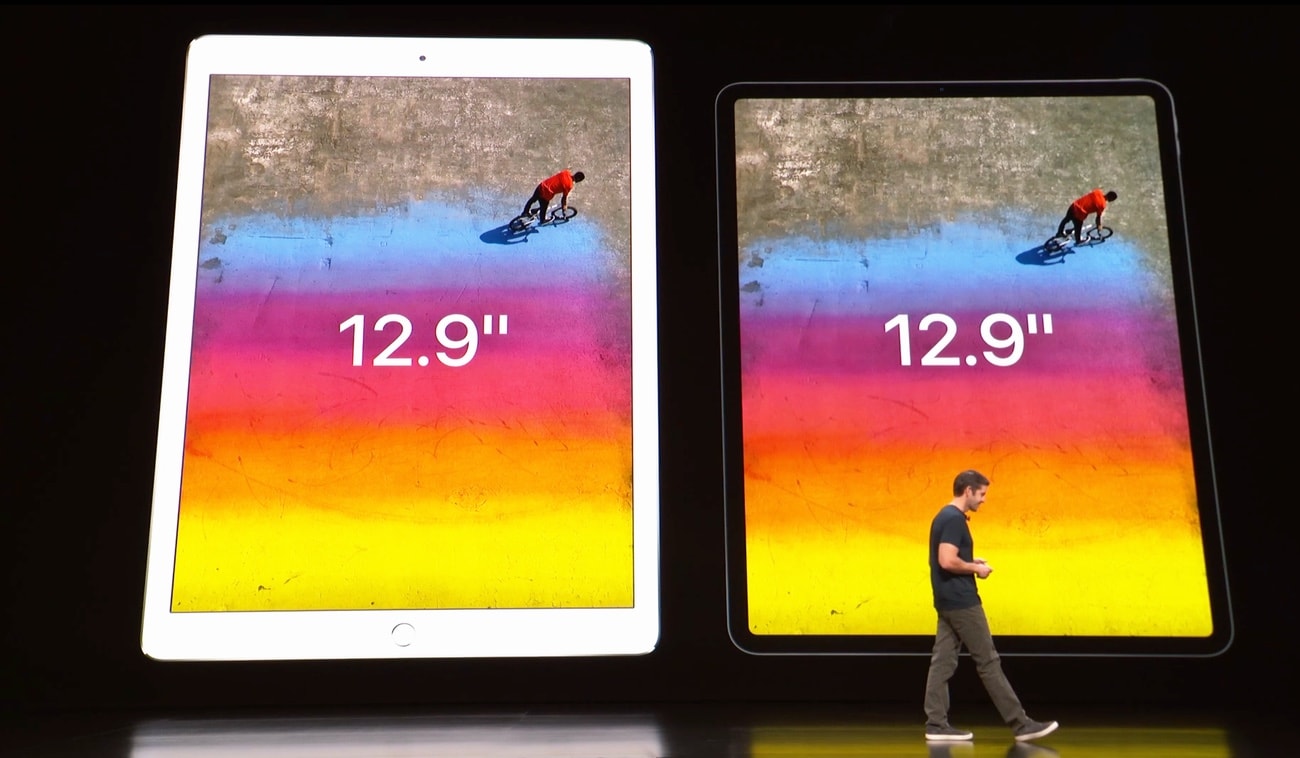Since the first iPad was unveiled back in 2010, each successive model has looked nearly that same as all its predecessors, with most changes coming from faster processors and more storage.
Not any more. The iPad Pro just revealed includes several dramatic improvements, any one of which would be a game changer.
Don’t miss our comprehensive comparison of this tablet with the 2017 version.
Size matters
Even a quick glance at the 2018 iPad Pro shows that it has a new form factor. The hefty bezels at the top and bottom of the screen on all earlier versions are gone. A closer examination is required to see that the side bezels have been trimmed as well.
As a real-world comparison, Apple proudly announced that the new 12.9-inch version is about the size of a sheet of paper.
Not surprisingly, the major difference in size between last year’s 12.9-inch model and this year’s is in their height. Apple whacked an inch off top and bottom. And it’s thinner and slimmer than its predecessors.
The height of the smaller model didn’t change much, and it’s actually slightly wider, but that’s because Apple put in a bigger screen. More on this in a minute.

Photo: Ed Hardy/Cult of Mac
It’s screen time
Apple left the 12.9-inch display in the larger version of the new iPad Pro practicality unchanged. It has the same resolution and pixels per inch. The only tweak is that the corners are rounded to match the casing.
But there’s a significant change in the smaller version: the 10.5-inch display has been replaced with an 11-inch one. That brought an increase in the resolution so the pixels per inch would stay at 264. Bigger is always better, especially when the overall tablet is actually shrinking slightly.

Photo: Apple
iOS 12 brought new screen gestures for opening the Dock, swapping apps, and opening the Control Center. These work on last year’s iPads as well as the new ones.
Touch ID out, Face ID in
Apple was able to remove the hefty bottom bezel because it ejected the Home button. This allowed the new models to shrink, but the Home button is familiar to millions of iPad users and some will undoubtedly miss it. All its functionality has been replaced, though.
Previous iPad Pro versions used a Touch ID scanner in the Home button. This fingerprint-scanning tech has it’s fans, so there’ll likely be complaints about it going away too.
But it’s been supplanted by Face ID. This is more secure than its predecessor, and the necessary equipment also enables personalized Memoji to mimic our facial expressions.
At least Apple was finally able to force this biometric security system to work in both portrait and landscape modes. Otherwise, Touch ID would have a significant advantage.
USB-C not Lightning
If Apple had made no other changes to the 2018 iPad Pro, it would still be a landmark device for being the first iOS model of any type with a USB-C port in place of the Lightning connector.

Photo: Apple
That said, this first implementation of this standard is limited. It supports external monitors up to 5K. And that’s as an extended display, though it’s apparently up to third-party developers to add this feature to their software.
The Lightning port on last year’s iPad Pro could do screen mirroring with the right adapter, or with an Apple TV.
Beyond more screen functionality, the USB-C port on the 2018 iPad Pro does about the same as the Lightning port on older tablets. External drives can only be used to import pictures, and there’s no mouse support. Both USB-C and Lightning can be used for charging, of course.
Here’s hoping that next year’s iOS 13 adds to the functionality of the USB-C port. Still, what we have now is a huge step in the right direction.
While we’re on the topic of ports, the 2017 models have a headset jack, while the 2018 iPad Pro does not. Some people will likely see that as an advantage for the earlier tablet.
Faster, of course
Apple designs its own CPUs, and makes sure faster ones come out every year. So its no surprise that the 2018 iPad Pro has a new Apple A12X Bionic chip. We don’t have the exact speed yet, as Apple never announces this, but Apple promises this octa-core processor is up to 90 percent quicker than its previous tablet.
That’s possible because the 2017 slates came out before the A11 was available. So they are running an A10X, which is really two generations ago. And this is a hexa-core processor, so it offers fewer cores. It runs at up to 2.39 GHz.
An amazing 1TB of storage
Some people still think the iPad is a toy. Not Apple. There’s no better demonstration of that than the option to get 1 terabyte of storage in the latest iPad Pro. That’s twice as much as any previous model.
That said, the other storage options didn’t change. The latest iOS tablets can also be configured with either 64GB, 256GB, or 512GB of capacity, the same as their predecessors.
Get out your wallet
A definite change, though hardly a welcome one, is an increase in price. Last year, the base 12.9-inch iPad Pro was $799. The new 2018 version is $200 more than that.
The 10.5-inch version started at $649, and it’s been replaced by an 11-inch model that starts at $799.
Adding additional storage to these, as well as 4G LTE, pushes up the price. Much has already been made of the fact that the 1TB version of the new 12.9-inch model is $1749.
Still, in a world where the iPhone XS Max starts at $1099, these devices might start to seem like a bargain.
You make the call
It’s not often that Apple changes one of its products enough in a year that an upgrade makes sense. This year might just be an exception.
The 2018 iPad Pro is more portable than its predecessors without sacrificing screen size. And the switch to USB-C is potentially huge, though right now it mostly helps those who want to use external monitors. The new tablet is faster, with much more storage available.
It is expensive. The 2017 iPad Pro models were already pricey, and their replacements are even more so. So anyone who has an older tablet they’d like to turn into cash should check out our trade-in program.
If you decide to forgo this newest model and wait for its replacement, remember that Apple refreshes its tablets about every 18 months. Think about whether you can wait until 2020 for a new iPad.


